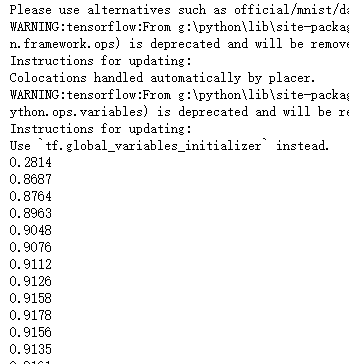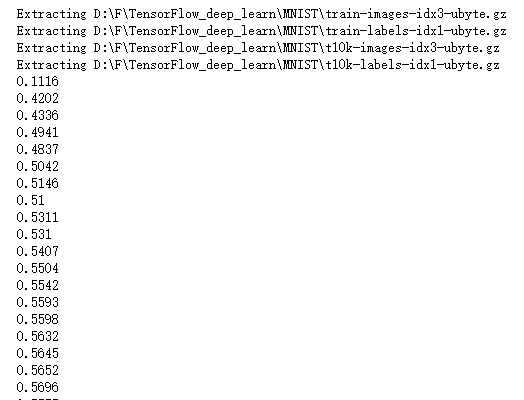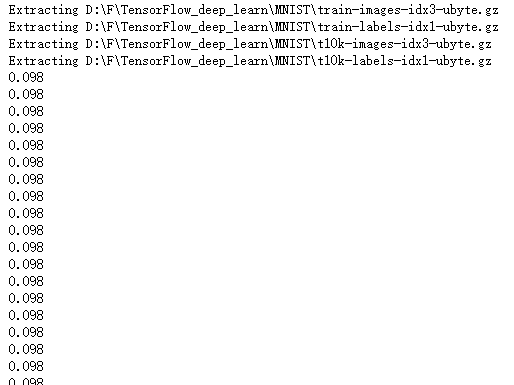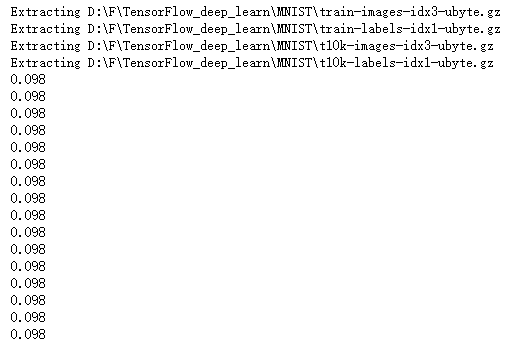吴裕雄 python深度学习与实践(15)
import tensorflow as tf
import tensorflow.examples.tutorials.mnist.input_data as input_data mnist = input_data.read_data_sets("D:\\F\\TensorFlow_deep_learn\\MNIST\\", one_hot=True) x_data = tf.placeholder("float32", [None, 784])
weight = tf.Variable(tf.ones([784, 10]))
bias = tf.Variable(tf.ones([10]))
y_model = tf.nn.softmax(tf.matmul(x_data, weight) + bias)
y_data = tf.placeholder("float32", [None, 10]) loss = tf.reduce_sum(tf.pow((y_model - y_data), 2)) train_step = tf.train.GradientDescentOptimizer(0.01).minimize(loss)
init = tf.initialize_all_variables()
sess = tf.Session()
sess.run(init) for _ in range(1000):
batch_xs, batch_ys = mnist.train.next_batch(100)
sess.run(train_step, feed_dict={x_data:batch_xs, y_data:batch_ys})
if _ % 50 == 0:
correct_prediction = tf.equal(tf.argmax(y_model, 1), tf.argmax(y_data, 1))
accuracy = tf.reduce_mean(tf.cast(correct_prediction, "float"))
print(sess.run(accuracy, feed_dict={x_data: mnist.test.images, y_data: mnist.test.labels}))

import tensorflow as tf
import tensorflow.examples.tutorials.mnist.input_data as input_data mnist = input_data.read_data_sets("D:\\F\\TensorFlow_deep_learn\\MNIST\\", one_hot=True) x_data = tf.placeholder("float32", [None, 784])
weight = tf.Variable(tf.ones([784, 10]))
bias = tf.Variable(tf.ones([10]))
y_model = tf.nn.relu(tf.matmul(x_data, weight) + bias)
y_data = tf.placeholder("float32", [None, 10])
loss = -tf.reduce_sum(y_data*tf.log(y_model)) train_step = tf.train.GradientDescentOptimizer(0.01).minimize(loss)
init = tf.initialize_all_variables()
sess = tf.Session()
sess.run(init) for _ in range(1000):
batch_xs, batch_ys = mnist.train.next_batch(50)
sess.run(train_step, feed_dict={x_data:batch_xs, y_data:batch_ys})
if _ % 50 == 0:
correct_prediction = tf.equal(tf.argmax(y_model, 1), tf.argmax(y_data, 1))
accuracy = tf.reduce_mean(tf.cast(correct_prediction, "float"))
print(sess.run(accuracy, feed_dict={x_data: mnist.test.images, y_data: mnist.test.labels}))

import tensorflow as tf
import tensorflow.examples.tutorials.mnist.input_data as input_data mnist = input_data.read_data_sets("D:\\F\\TensorFlow_deep_learn\\MNIST\\", one_hot=True) x_data = tf.placeholder("float32", [None, 784]) weight1 = tf.Variable(tf.ones([784, 256]))
bias1 = tf.Variable(tf.ones([256]))
y1_model1 = tf.matmul(x_data, weight1) + bias1 weight2 = tf.Variable(tf.ones([256, 10]))
bias2 = tf.Variable(tf.ones([10]))
y_model = tf.nn.softmax(tf.matmul(y1_model1, weight2) + bias2) y_data = tf.placeholder("float32", [None, 10]) loss = -tf.reduce_sum(y_data*tf.log(y_model))
train_step = tf.train.GradientDescentOptimizer(0.01).minimize(loss)
init = tf.initialize_all_variables()
sess = tf.Session()
sess.run(init) for _ in range(1000):
batch_xs, batch_ys = mnist.train.next_batch(50)
sess.run(train_step, feed_dict={x_data:batch_xs, y_data:batch_ys})
if _ % 50 == 0:
correct_prediction = tf.equal(tf.argmax(y_model, 1), tf.argmax(y_data, 1))
accuracy = tf.reduce_mean(tf.cast(correct_prediction, "float"))
print(sess.run(accuracy, feed_dict={x_data: mnist.test.images, y_data: mnist.test.labels}))

import tensorflow as tf
import tensorflow.examples.tutorials.mnist.input_data as input_data mnist = input_data.read_data_sets("D:\\F\\TensorFlow_deep_learn\\MNIST\\", one_hot=True) x_data = tf.placeholder("float32", [None, 784])
x_image = tf.reshape(x_data, [-1,28,28,1]) w_conv = tf.Variable(tf.ones([5,5,1,32]))
b_conv = tf.Variable(tf.ones([32]))
h_conv = tf.nn.relu(tf.nn.conv2d(x_image, w_conv, strides=[1, 1, 1, 1], padding='SAME') + b_conv) h_pool = tf.nn.max_pool(h_conv, ksize=[1, 2, 2, 1],strides=[1, 2, 2, 1], padding='SAME') w_fc = tf.Variable(tf.ones([14*14*32,1024]))
b_fc = tf.Variable(tf.ones([1024])) h_pool_flat = tf.reshape(h_pool, [-1, 14*14*32])
h_fc = tf.nn.relu(tf.matmul(h_pool_flat, w_fc) + b_fc) W_fc2 = tf.Variable(tf.ones([1024,10]))
b_fc2 = tf.Variable(tf.ones([10])) y_model = tf.nn.softmax(tf.matmul(h_fc, W_fc2) + b_fc2) y_data = tf.placeholder("float32", [None, 10]) loss = -tf.reduce_sum(y_data*tf.log(y_model))
train_step = tf.train.GradientDescentOptimizer(0.01).minimize(loss)
init = tf.initialize_all_variables()
sess = tf.Session()
sess.run(init) for _ in range(1000):
batch_xs, batch_ys = mnist.train.next_batch(200)
sess.run(train_step, feed_dict={x_data:batch_xs, y_data:batch_ys})
if _ % 50 == 0:
correct_prediction = tf.equal(tf.argmax(y_model, 1), tf.argmax(y_data, 1))
accuracy = tf.reduce_mean(tf.cast(correct_prediction, "float"))
print(sess.run(accuracy, feed_dict={x_data: mnist.test.images, y_data: mnist.test.labels}))

import tensorflow as tf
import tensorflow.examples.tutorials.mnist.input_data as input_data mnist = input_data.read_data_sets("D:\\F\\TensorFlow_deep_learn\\MNIST\\", one_hot=True) x_data = tf.placeholder("float", shape=[None, 784])
y_data = tf.placeholder("float", shape=[None, 10]) def weight_variable(shape):
initial = tf.truncated_normal(shape, stddev=0.1)
return tf.Variable(initial) def bias_variable(shape):
initial = tf.constant(0.1, shape=shape)
return tf.Variable(initial) def conv2d(x, W):
return tf.nn.conv2d(x, W, strides=[1, 1, 1, 1], padding='VALID') def max_pool_2x2(x):
return tf.nn.max_pool(x, ksize=[1, 2, 2, 1], strides=[1, 2, 2, 1], padding='VALID') W_conv1 = weight_variable([5, 5, 1, 32])
b_conv1 = bias_variable([32])
x_image = tf.reshape(x_data, [-1, 28, 28, 1])
h_conv1 = tf.nn.relu(conv2d(x_image, W_conv1) + b_conv1)
h_pool1 = max_pool_2x2(h_conv1) W_conv2 = weight_variable([5, 5, 32, 64])
b_conv2 = bias_variable([64])
h_conv2 = tf.nn.relu(conv2d(h_pool1, W_conv2) + b_conv2)
h_pool2 = max_pool_2x2(h_conv2) W_fc1 = weight_variable([4 * 4 * 64, 1024])
b_fc1 = bias_variable([1024]) h_pool2_flat = tf.reshape(h_pool2, [-1, 4*4*64])
h_fc1 = tf.nn.relu(tf.matmul(h_pool2_flat, W_fc1) + b_fc1) keep_prob = tf.placeholder("float")
h_fc1_drop = tf.nn.dropout(h_fc1, keep_prob) W_fc2 = weight_variable([1024, 10])
b_fc2 = bias_variable([10]) y_conv=tf.nn.softmax(tf.matmul(h_fc1_drop, W_fc2) + b_fc2) cross_entropy = -tf.reduce_sum(y_data * tf.log(y_conv))
train_step = tf.train.AdamOptimizer(1e-2).minimize(cross_entropy)
correct_prediction = tf.equal(tf.argmax(y_conv,1), tf.argmax(y_data, 1))
accuracy = tf.reduce_mean(tf.cast(correct_prediction, "float")) sess = tf.Session()
sess.run(tf.initialize_all_variables()) for i in range(1000):
batch = mnist.train.next_batch(50)
if i%5 == 0:
train_accuracy = sess.run(accuracy, feed_dict={x_data:batch[0], y_data: batch[1], keep_prob: 1.0})
print("step %d, training accuracy %g"%(i, train_accuracy))
sess.run(train_step, feed_dict={x_data: batch[0], y_data: batch[1], keep_prob: 0.5})

吴裕雄 python深度学习与实践(15)的更多相关文章
- 吴裕雄 python深度学习与实践(13)
import numpy as np import matplotlib.pyplot as plt x_data = np.random.randn(10) print(x_data) y_data ...
- 吴裕雄 python深度学习与实践(18)
# coding: utf-8 import time import numpy as np import tensorflow as tf import _pickle as pickle impo ...
- 吴裕雄 python深度学习与实践(17)
import tensorflow as tf from tensorflow.examples.tutorials.mnist import input_data import time # 声明输 ...
- 吴裕雄 python深度学习与实践(16)
import struct import numpy as np import matplotlib.pyplot as plt dateMat = np.ones((7,7)) kernel = n ...
- 吴裕雄 python深度学习与实践(14)
import numpy as np import tensorflow as tf import matplotlib.pyplot as plt threshold = 1.0e-2 x1_dat ...
- 吴裕雄 python深度学习与实践(12)
import tensorflow as tf q = tf.FIFOQueue(,"float32") counter = tf.Variable(0.0) add_op = t ...
- 吴裕雄 python深度学习与实践(11)
import numpy as np from matplotlib import pyplot as plt A = np.array([[5],[4]]) C = np.array([[4],[6 ...
- 吴裕雄 python深度学习与实践(10)
import tensorflow as tf input1 = tf.constant(1) print(input1) input2 = tf.Variable(2,tf.int32) print ...
- 吴裕雄 python深度学习与实践(9)
import numpy as np import tensorflow as tf inputX = np.random.rand(100) inputY = np.multiply(3,input ...
随机推荐
- 神州数码OSPF Stub(末梢区域)和Totally Stub(完全末梢区域)的配置
实验要求:了解末梢区域及完全末梢区域的配置 拓扑如下 R1 enable 进入特权模式 config 进入全局模式 hostname R1 修改名称 interface l0 进入端口 ip addr ...
- Java六大必须理解的问题
Java六大必须理解的问题 对于这个系列里的问题,每个学Java的人都应该搞懂.当然,如果只是学Java玩玩就无所谓了.如果你认为自己已经超越初学者了,却不很懂这些问题,请将你自己重归初学者行列.内容 ...
- C/C++ 宏技巧
1. C 也可以模板化 #define DEFINE_ARRAY_TYPE(array_type_, element_type_) \ static inline int array_type_ ## ...
- message box
QMessageBox 弹出框上的按钮设置为中文 Qt 默认的弹出框上的按钮式英文,虽然也知道是什么意思,但终究不如中文看着顺眼. QMessageBox box(QMessageBox::War ...
- SSH(远程登录)原理
最近在研究hadoop,因为是分布式的,会涉及很多机器协作工作,但所有的操作都是需要进行权限验证的,namenode主机会尝试启动datanode主机上的进程等等.下面就用一张图来解释SSH登录验证的 ...
- spring mvc 为什么这么多xml
spring web mvc 处理流程 Architecture web.xml (webapp必要配置) 作用:spring web mvc 使用dispatcherServlet 分发reques ...
- Processing 编程学习指南 (丹尼尔·希夫曼 著)
https://processing.org/reference/ 第1章 像素 (已看) 第2章 Processing (已看) 第3章 交互 (已看) 第4章 变量 (已看) 第5章 条件语句 ( ...
- Session、Cookie、Cache、Token分别是什么及区别
一.Session 1 )Session 解释 Session 是单用户的会话状态.当用户访问网站时,产生一个 sessionid.并存在于 cookies中.每次向服务器请求时,发送这个 cooki ...
- yum源搭建
1:vim /etc/yum.repo.d/ll.repo [local] 这里不能有空格,如[local yum] name=local baseurl=file:///yum gpgcheck ...
- 涨知识:equals 和 == 你真的了解吗?
基本概念 ==是运算符,比较的是两个变量是否相等: equals()是Object方法,用于比较两个对象是否相等 看一下源码: public boolean equals(Object anObjec ...
